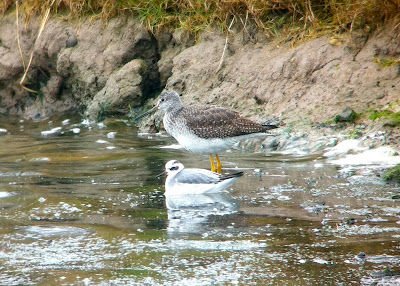This species has been a nemesis of mine for longer than I care to remember. Most that have occurred in Britain have been 'one day wonders' during the week and twitchable ones have often turned up when I have been at opposite ends of the country. A perfect example was the time a group of us decided to head down to Cornwall for a weekend of rarity hunting during September 2006 and a bird appeared at Carmel Head on Anglesey. After planning the route we estimated that it would take us nearly seven hours to drive the 430 miles from Penzance to Anglesey. Needless to say we soon knocked any idea of twitching that particular bird firmly on the head. After an enjoyable few days in the south west seeing such rarities as
WILSON'S PHALAROPE and scarcities such as
Dotterel, 2
Pectoral Sandpiper,
Wryneck and
Melodious Warbler I decided to head over to Anglesey the following Monday morning. After showing well for the previous two days I well and truly dipped. To rub salt into the wounds there was another alleged sighting of the bird during that evening as I crossed the border into England.
Just a few weeks ago I was over in North Norfolk chasing a
RED-FLANKED BLUETAIL around Holme when an 'Izzy Wheatear' turned up in Sussex. The disappointment of missing out on the
RUFOUS-TAILED ROBIN from the previous day increased slightly but at least the handsome Bluetail eventually showed well as a consolation prize. To add to the frustration not a year goes by when a pallid looking
Northern Wheatear is misidentified as this species. The plumage differences are indeed quite subtle but having studied plenty of
ISABELLINE WHEATEARS on their breeding grounds on the Greek island of Lesvos, the structure and feel of this species is something quite different.
So late on Friday afternoon news filtered through of a probable
ISABELLINE WHEATEAR in East Yorkshire. Considering the bird was at Spurn and was no doubt being scrutinised by a handful of skillful birders I was very optimistic. My faith was rewarded when it was initially confirmed as such in the field before being trapped and ringed. Now would the bird hang around until the following morning? With a staggering 76% of all British mainland sightings of this species making just single day appearances, the odds were stacked firmly against me once again.
On Saturday morning I woke up early and half-heartedly sorted the birding kit in anticipation of sheer disappointment. There was no point in getting up to Spurn for first light and anyway, if the bird was still present there was little chance that it would depart during daylight hours. At around 7.15am I received a call from Spurn regular
Adam Hutt. Amazingly the bird was still there and showing very well! We left North Warwickshire within minutes, collected
Snapper Richards and
Stevie Dunn from Tibshelf and we were on our way.
A few tense hours later we finally arrived at The Warren on the Spurn peninsula. We abandoned the car and made our way towards The Point at a brisk pace. Arriving back in the opposite direction were a stream of smarmy early birders including
Mike Feely,
Rich Challands, and
Ash Howe. We also bumped into
Rich Collis and grilled him about the birds habits and favoured location. What came back in reply was a indiscernible, garbled South Yorkshire drawl reminiscent of
Vic Reeves's 'pub singer' impression. It would have been more useful asking
Chewbacca his recommendations regarding a rare
Oenanthe species.
 |
ISABELLINE WHEATEAR - Spurn, East Yorkshire.
Photo kindly provided by Craig Shaw |
Eventually we arrived on site to view the bird on the River Humber side of the strip. Just as we set up our scopes though the bird flew along the beach and kept heading off into the distance. Panic set in briefly before it settled down to feed once again. In flight the bird was pale and slightly larger looking than an immature or female
Northern Wheatear. It also showed the bright, white underwing as it whizzed past. Some young female
Northern Wheatears can show a light coloured underwing too but nothing as striking as this bird did. All of the group had scored with a new addition to our
British Lists however better views were needed.
 |
| ISABELLINE WHEATEAR by Craig Shaw |
As it fed nimbly around the sandy terrain the bird often showed a long-necked, upright stance as well as a longer tarsi and a shorter tail. In the field the bird had a pretty prominent paler supercilium before the eye rather than behind, a feature not particularly present in these photographs. The differences between the colouration of the upperparts and underparts were not substantial and the dark alula often stood out. We were also lucky to see the bird preen when it once again showed the white underwing along with the prominent wider dark tail-band.
 |
| ISABELLINE WHEATEAR by Craig Shaw |
We continued to soaked up the bird for around ninety minutes in total as it moved up and down a section of the beach. Except for an impressive array of common waders and a few flocks of
Fieldfare and
Redwing arriving in off the sea there was not a great deal of other species to choose from in the blustery conditions. After a fruitless search around the Blue Bell Inn area we decided to head off into Hull and celebrate with the customary ingestion of assorted junk food before heading back down to the Midlands. After years of pain and disappointment
ISABELLINE WHEATEAR had finally been nailed in Britain. It was smiles all around.
 |
| Spurn success! Me, Stevie & Snapper all scoop a British List addition. |

























